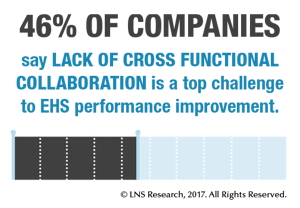The goals of environment, health and safety (EHS) management have remained relatively constant since I started my career as a corporate EHS professional with Alcoa in the 1980s. Keep people and the environment safe, and the plant running smoothly. Stay in compliance and manage risks to prevent problems. Look for opportunities to help the business grow profitably.
 What’s changed are the challenges and opportunities EHS leaders face in achieving these goals. Most recently, the digital revolution known as Industry 4.0 has started to disrupt industries as companies transform business models, processes, and performance. This creates new business and operational risks along with new opportunities to optimize performance. How can EHS leaders survive and even thrive in the wake of Digital Transformation?
What’s changed are the challenges and opportunities EHS leaders face in achieving these goals. Most recently, the digital revolution known as Industry 4.0 has started to disrupt industries as companies transform business models, processes, and performance. This creates new business and operational risks along with new opportunities to optimize performance. How can EHS leaders survive and even thrive in the wake of Digital Transformation?
Enter EHS 4.0, a new framework to leverage technology to overcome the limitations of traditional approaches to EHS management.
Limitations of Traditional EHS Management
The art and science of EHS management is well-developed, with great advancement in recent decades in the management systems and programs used to manage compliance and risk. Industry-wide performance as reflected in incident rates and fatalities has consistently improved over the years. Despite progress across industry, many organizations get stuck in their EHS and safety improvement journeys.
 Our EHS management and Operational Excellence research consistently shows that the main barriers to performance improvement are disparate systems and data sources, and lack of cross-functional collaboration. Silos of information, process, and organization block improvement. These disconnects cause gaps in management system execution, which in turn result in incidents and adverse events. The LNS Research EHS 4.0 framework provides a vehicle to improve the situation.
Our EHS management and Operational Excellence research consistently shows that the main barriers to performance improvement are disparate systems and data sources, and lack of cross-functional collaboration. Silos of information, process, and organization block improvement. These disconnects cause gaps in management system execution, which in turn result in incidents and adverse events. The LNS Research EHS 4.0 framework provides a vehicle to improve the situation.
Why EHS 4.0?
EHS 4.0 is a reference to Industry 4.0, also known as the Fourth Industrial Revolution or Smart Manufacturing. Industry 4.0 makes use of cyber-physical systems to connect people, machines, and data in new ways. Key technology advances including sensor-equipped devices, cloud computing, mobile apps, and Big Data analytics enable the overarching trend of the Industrial Internet of Things (IIoT). In this digital era, smart connected assets help optimize industrial operations with predictive/autonomous control.
EHS 4.0 provides the means to harness today’s technology to enable fresh approaches to EHS management. EHS 4.0 is not a technology per se but rather is enabled by technology innovations. It’s a framework of capabilities that can help organizations go beyond traditional EHS management to transform how they manage performance improvement.
The 7 Dimensions of EHS 4.0
 While EHS 4.0 includes the digitalization of EHS management, more important is the impact of that digitalization on technology, processes, and people, and ultimately performance. LNS Research has identified seven essential dimensions of EHS 4.0 which can be used to inform, plan, and act. It doesn’t replace traditional EHS approaches and methods. Instead, it helps EHS business leaders pinpoint how they can improve existing capabilities and initiatives, and further integrate EHS into business strategy and operations. The seven EHS 4.0 dimensions are:
While EHS 4.0 includes the digitalization of EHS management, more important is the impact of that digitalization on technology, processes, and people, and ultimately performance. LNS Research has identified seven essential dimensions of EHS 4.0 which can be used to inform, plan, and act. It doesn’t replace traditional EHS approaches and methods. Instead, it helps EHS business leaders pinpoint how they can improve existing capabilities and initiatives, and further integrate EHS into business strategy and operations. The seven EHS 4.0 dimensions are:
- Strategic | EHS 4.0 brings the opportunity to further elevate the business value of EHS management based on effective leadership and strategic business alignment.
- Systematic | We’re entering a new era of management systems execution and compliance assurance based on process standardization, harmonized systems, and advanced analytics.
- Risk-based | Technology enables proactive, systematic processes for managing safety and environmental risks, to predict and prevent adverse business impacts.
- Connected | EHS 4.0 enables collaboration and communication to break down cross-functional silos and provides process integration and decision-support information from "shop floor to top floor."
- Smart | Data-driven decision-making includes a sufficient volume of the right types of data, and the application of advanced analytics technology to extract actionable insights.
- Agile | Agile EHS management means the ability to successfully adapt to internal and external change, and requires enterprise scalability and the capability to quickly create and deploy new applications.
- Engaged | EHS 4.0 enables a motivated workforce collaborating to achieve organizational objectives based on effective competency management and an organizational culture of operational excellence.
EHS Management is Behind on the Digital Curve
Core business operations have led the Digital Transformation wave in most industrial companies, with use cases such as asset reliability, production efficiency, and product quality. By comparison, EHS has been mostly a bystander in the Industry 4.0 movement, and a significant, if unintended, beneficiary of investments to date. For example, improvements in asset reliability help reduce equipment-related injuries, process safety incidents, and environmental emissions.
Now the role of the “digital worker” becomes much more prominent. Connected worker scenarios such as situational awareness, exposure monitoring, and ergonomics will become common, along with asset-oriented environmental, energy, and process safety use cases.
This setting represents an excellent opportunity for EHS business leaders. Many organizations have already launched Digital Transformation initiatives, and have processes and resources in place to do more. In many cases, the digital ground has been plowed and is ready for planting. In this opportunity-rich environment, it's a good time for EHS leaders to be proactive and make the business case for investment. The alternative is to stand by as change occurs without you, and risk being left behind.